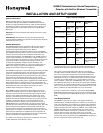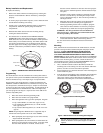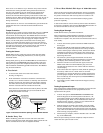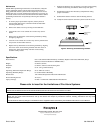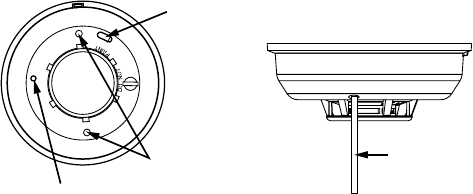
- 3 -
Dust covers are an effective way to limit the entry of dust into the
smoke detector sensing chamber during construction. However,
they may not completely prevent airborne dust particles from
entering the detector. Therefore, it is recommended that the
detectors be removed before beginning construction or other dust
producing activity. When returning the system to service, be sure to
remove the dust covers from any detectors that were left in place
during construction.
Smoke detectors are not to be used with detector guards unless the
combination has been evaluated and found suitable for that
purpose.
Tamper Protection
This detector has a built-in tamper switch that will cause a CHECK
signal to be displayed at the console of the alarm system if it is
removed from its mounting base. The 5808W3 detector includes a
tamper-resistant feature that prevents removal from the mounting
base without the use of a tool. To engage the tamper-resistant
feature, cut the small plastic tab located on the mounting base
(Figure 2), and then install the detector. To remove the detector
from the base once it has been made tamper resistant, use a small
screwdriver to depress the square tamper release tab, located on
the skirt of the mounting base, and turn the detector
counterclockwise.
Testing the Sensor
NOTE: Before testing, notify the central station that the smoke
detector system is undergoing maintenance, in order to prevent
unwanted alarms.
During initial power-up, do not use SENS-RDR or canned smoke to
test the detector. The SENS-RDR and canned aerosol can be used
after power-up sequence has completed. Detectors must be tested
after installation and following periodic maintenance. The 5808W3
may be tested as follows:
A. Test Switch
1. A recessed test switch is located on the detector
housing (see Figure 4).
2. Push and hold the recessed test switch for a minimum of 5
seconds. Use a small screwdriver or Allen key with maximum
diameter of 0.18 inch (the alarm panel will trigger and then
the smoke detector will go into alarm. If the tool is removed
from the recessed switch the sounder will shut off.)
If the detector is within the listed sensitivity limits, the LED
on the detector should blink once per second and the horn
should sound within 3 seconds.
LED
RECESSED TEST SWITCH
POSITION SENS-RDR
AT AN ANGLE ON THE
OVAL AREA OR AT THE
CHAMBER OPENING
BY THE WORD “PAINT”
PUSH RECESSED
SWITCH WITH
A 0.18″ MAX.
DIAMETER TOOL
Figure 4. Recessed Test Switch Opening and SENS-RDR Position
B. Smoke Entry Test
Hold a smoldering punk stick or cotton wick at the side of the
detector and gently blow smoke through the detector until the unit
alarms. Canned aerosol is also an acceptable method.
C. Direct Heat Method (Hair dryer of 1000-1500 watts)
Direct the heat toward either side thermistor. Be sure to hold the
heat source about 12 inches from the detector to avoid damage to
the plastic. The detector will reset only after it has time to cool.
Smoke detection testing is recommended for verifying system
protection capability.
A detector that fails to activate with any of these tests should first
be cleaned as outlined in this manual’s MAINTENANCE section. If
the detector still fails to activate, return for repair.
Testing Signal Strength
NOTE: Remove battery tab before installation.
This test should be performed before installation to determine a
strong communication path with the control panel and after
installation is complete. Also, the owner/user should test the unit at
least weekly.
1. Activate the wireless system’s GO/NO GO TEST mode from
the keypad.
2. Depress and hold the smoke detector’s TEST switch. If the
detector has not previously detected a low battery condition
and it is within proper sensitivity limits, the detector should
immediately transmit an alarm signal to the control panel.
The built-in horn will start to sound about 2.5 seconds after
depressing the button.
3. The wireless system’s keypad should emit at least three
audible sounds when the alarm transmission is received and
will display the transmitting detector’s zone number.
4. When the console has received the test signal, release the
TEST switch. The horn will immediately stop and a few
seconds later the detector’s zone number will clear from the
console display.
5. If the console does not respond as noted, check the polarity of
the battery and be sure it is fresh. If this is an initial
installation, try moving the detector to another location that
provides proper reception. Also be sure that the detector has
been “enrolled” by the control panel (see PROGRAMMING).
Then, repeat the test.
6. Turn off the system’s TEST mode from the keypad (security
code + OFF).
Testing Programmed Loops
This test should be performed before installation to ensure that all
loops intended to be used have been programmed and are
operational in the system.
1. Activate the system’s TRANSMITTER ID SNIFFER mode
from the keypad (see the control panel’s instructions). All
programmed wireless zones will be displayed, one by one, on
the system keypad. Make sure all smoke detector zones are
displayed in the sequence. (If they are not, recheck that all
zones have been properly programmed.)
2. With the detector mounted to the bracket, press the smoke
detector’s TEST switch. All zones associated with the smoke
detector should disappear from the keypad on the next display
cycle. This means that the system has received a transmission
from each loop you programmed.
3. When testing is complete, enter the Installer code + the OFF
key to exit TEST mode.
When all system testing has been completed, notify the central
station that the system is back on line.



